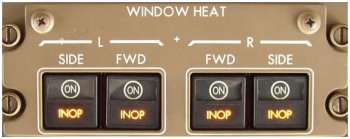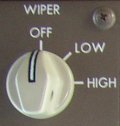Anti-Ice and Rain - Windows
Flight Deck Window Heat

The windshields consist of 3 panes, an inner, middle and outer. The outer pane is not a structural pane and if damaged, exhibits a large cracking pattern with good residual vision capability. The inner and middle panes exhibit an intense cracking pattern which obscures vision.
All flight deck windows are electrically heated. The forward windows have anti-icing protection and anti-fogging. The side windows have anti-fogging protection only.
Window Heat Control
The WINDOW HEAT switches control heating for all flight deck windows. With the switches ON, window heat operates as soon as electrical power is established. The windows are protected from thermal shock when the switches are initially placed ON.
In addition to the electric heating, conditioned air is ducted to the top of the forward windows and then flows along the inside surface to provide supplemental anti-fogging. The anti-fogging airflow is continuous and is independent of electric window heat.
Window Heat Inoperative Lights
 One INOP light illuminates and the EICAS advisory message L/R FWD WINDOW or L/R SIDE WINDOW displays to indicate a window is not being heated due to a fault or overheat condition. If two or more INOP lights illuminate, the EICAS advisory message WINDOW HEAT displays.
One INOP light illuminates and the EICAS advisory message L/R FWD WINDOW or L/R SIDE WINDOW displays to indicate a window is not being heated due to a fault or overheat condition. If two or more INOP lights illuminate, the EICAS advisory message WINDOW HEAT displays.
If the INOP light is caused by an overheat, the system may be reset. After allowing the window to cool to its normal operating temperature, cycling the Window Heat Switch may restore heat to the window. If the system resets, the INOP light goes out when the window heat is turned on. A fault in the system is indicated if the system fails to reset and the INOP light remains on.
Fuel Jettison
Activation of the Fuel Jettison Switch (as installed) initiates electrical system load shedding and loss of window heat to the aft-most cockpit side windows. The WINDOW HEAT EICAS message will appear. Upon completion of fuel jettison, the window heat will automatically reset.
Window Heat Test
The window heat test checks the operational status of window heat system. Pushing the Window/Probe Heat Test Switch with the Window Heat Switches ON and the INOP lights extinguished, checks the system for faults. If no faults are detected the INOP lights extinguish and a WINDOW HEAT message is displayed on EICAS. The INOP lights extinguish and the EICAS message disappears when the test switch is released.
Windshield Wipers

The forward windows are equipped with two-speed wipers. With the WIPER selector in the OFF position, the wipers are off and stowed.
Scratching of the outer windshield may occur if the wipers are used on a dry windshield.
A three-position (OFF/LOW/HIGH) Windshield Wiper Selector controls the speed of the wipers. Except for the Windshield Wiper Selector, each windshield has a completely independent wiper system, including electrical power. Failure of any component or power source in one system does not affect the operation of the other.
Rain Repellent
SB Disables Rain Repellent System
As installed
Rain repellent may be applied to the windshields to augment the windshield wipers in creating a clear field of vision when rain is particularly intense. It should not be applied to both windshields simultaneously because it obscures vision initially until it has been evenly spread over the windshield surface. It should also never be applied to a dry windshield because it will obscure vision.
Do not use rain repellent to clean a windshield. It smears and obscures forward visibility if applied to a dry windshield. If rain repellent is inadvertently applied, do not use the windshield wipers until required for rain removal.
A push button switch is provided on the overhead panel for each windshield. Each push of a button delivers a pre-measured amount of repellent to the windshield.
A rain repellent can with a sight gauge, pressure gauge and a manual shutoff valve are located in the cockpit.